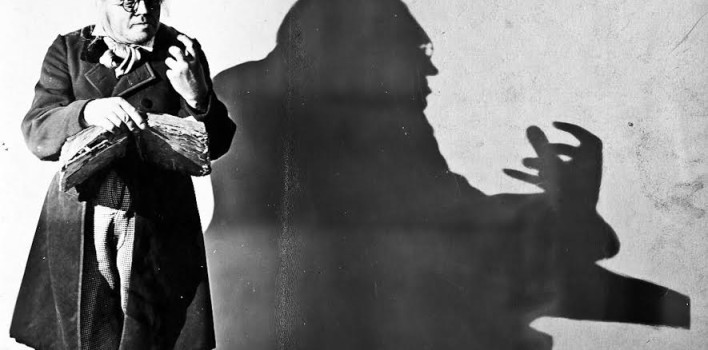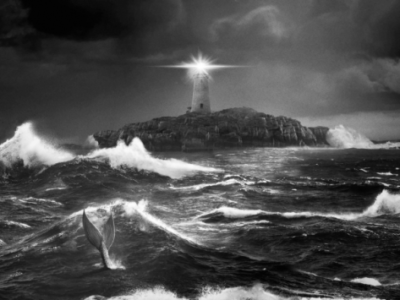Reviewing the Classics | The Cabinet of Dr. Caligari
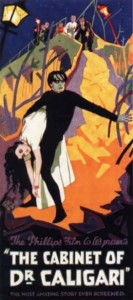 The Cabinet of Dr. Caligari is the silent film that made me want to watch more silent films. It was the very first one I saw and it remains my favorite of the era to this day. The 1920 production is considered the archetypal piece of German Expressionist cinema. It has even been referred to as the film that birthed horror and film noir genres as well. Essentially, it is a strong stone upon which much of later cinema was built.
The Cabinet of Dr. Caligari is the silent film that made me want to watch more silent films. It was the very first one I saw and it remains my favorite of the era to this day. The 1920 production is considered the archetypal piece of German Expressionist cinema. It has even been referred to as the film that birthed horror and film noir genres as well. Essentially, it is a strong stone upon which much of later cinema was built.
The story begins in an insane asylum with one man narrating his tale of how his friend Alan was killed and Alan’s fiancée kidnapped soon after. Alan takes Francis to a fair where they meet Dr. Caligari, an insane hypnotist who has in his exhibit a somnambulist (or sleepwalker) named Cesare. The attraction Caligari promises the public is that Cesare can predict the future on command and tell people when they will die. When Alan asks how long he has to live, Cesare responds morbidly that he has until dawn. Sure enough, by dawn, Alan has been murdered and Cesare is now a prime suspect. This killing follows a string of murders that police, and Francis, are now suspecting all lead to Caligari and his hoax with Cesare.
Though you will never hear their voices, the characters are unforgettable presences and, might I add, quite creepy. However, if you were to Google the actors (Werner Krauss, Conrad Veidt, and Lil Dagover to name a few) the difference in their appearance is unreal. This really showcases their acting ability and the phenomenal make-up and costume design that went into this production.
Even more captivating than the characters’ looks is the set design. This is what drew me and kept me glued to the screen. It’s so easy to see where directors like Hitchcock and Tim Burton garnered inspiration. The sets in this film are highly stylized, very two-dimensional and distorted. Even much of the lighting and shadows were actually painted directly onto the sets. It looks like something you would see in a dream, yet we are meant to accept it as reality. The film also leans upon what’s known as the “iris shot,” meaning the camera opens and closes scenes like an eye. I noticed upon my second and third viewings of the film how the iris shot likewise added to the aura of anxiety and discomfort.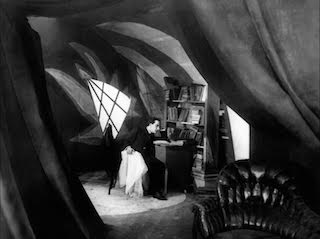
Francis is telling us a story, so the sets not only add to an eerie and alluring atmosphere, it also makes you question the validity of the story you’re being told. Is this real? Is it a dream? Is he insane? You feel on edge and uneasy in a realm of slanted walls and windows, spiral staircases, and general geodesic chaos. In many ways, the sets give the presence that this is a stage of sorts and that these characters are simply acting out theatrically in Francis’s mind. This also could be why the sets are so two-dimensional and less organic, because we are not seeing the truth. This is a genius move from director Robert Wiene and his production designers to create a world that’s almost believable, yet so bizarre you’ll be questioning it the entire time.
The film has a very interesting production backstory as its writers were involved in WWI and allegedly depicted their overall experience in symbolism throughout the film. One theory is that Dr. Caligari represents the German culture and government during wartime, thus making Cesare a symbol of the common man trained to kill for the gain of his authority figure. Some believe that this film, and others during the expressionist movement, actually predicted the events of WWII and Hitler’s reign because of these themes.
While I believe the writers more than likely did include personal experiences in their script, as most writers would, it’s kind of a far stretch to say this is a prediction of what happened after. This theme of authoritative ruthlessness and control has been a theme since the fall of man and history has a tendency to repeat itself. I like to think of Caligari not merely as a film about subjugation and tyranny, but a film made to push the creative boundaries of this “new” art form and thereby developing cinema.
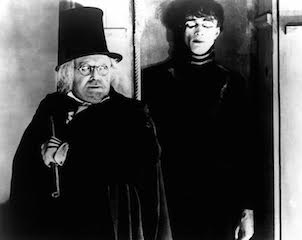 Another reason this film stands out is that it’s one of the first to utilize the concept of a twist ending. You think the story is going one way, and then it flips on you right after the climax. This of course is something we are all used to today, but in cinema’s early years it was revolutionary. Onward into the 40s with film noir, the twisty, turny plot had become an obsession of audiences everywhere, continually bringing them back for more.
Another reason this film stands out is that it’s one of the first to utilize the concept of a twist ending. You think the story is going one way, and then it flips on you right after the climax. This of course is something we are all used to today, but in cinema’s early years it was revolutionary. Onward into the 40s with film noir, the twisty, turny plot had become an obsession of audiences everywhere, continually bringing them back for more.
It would be amazing to go back in time to watch an audience reaction to this film and see the moment when their minds are totally blown. Though another problem this film may have faced is that the world during its time of release was a lot more superstitious and sensitized than we are now. It’s one of the films that many filmmakers and writers are continually inspired by and, because of this, it may be true that what’s inside Caligari’s Cabinet could be even more important and influential nearly a century later than ever before.


